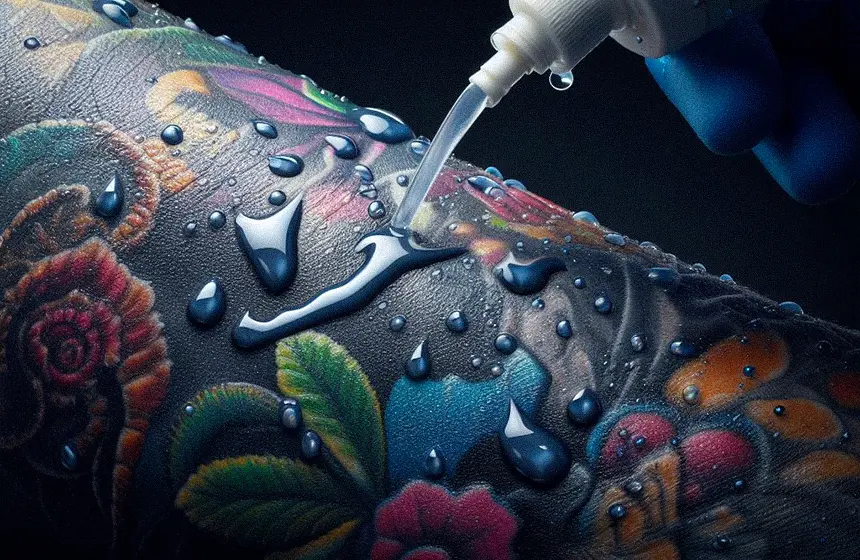I’ve discovered the art of waterproofing tattoos, learning from experts and experimenting.
Suppose you’re a tattoo owner planning to dive in. In that case, I’ll share my knowledge on safely waterproofing your tattoo for swimming, keeping it vibrant while you enjoy the water.
Table of Contents
Key Takeaways
- Wait until your tattoo is fully healed before going swimming.
- Use a waterproofing ointment or aftercare products to protect your tattoo before swimming.
- Consider wearing a rash guard or a waterproof bandage to provide extra protection.
- Clean your tattoo and surrounding skin thoroughly after swimming with warm water and antibacterial soap.
Waterproofing Techniques for Tattoos
If you’re planning to hit the pool or beach, protecting your tattoo from water is crucial. It’s not just about preserving the artwork but also about preventing potential skin irritations and infections. Let’s explore some effective methods to waterproof your tattoo before you take the plunge.
Understanding the Importance of Tattoo Protection
As a tattoo owner, I must understand the importance of protecting my tattoo, especially when it comes to waterproofing techniques for swimming. A fresh tattoo is an open wound, making it more susceptible to infections. Water bodies, especially swimming pools and oceans, are filled with bacteria that can harm my new ink. Chlorine, a common chemical in pools, can cause fading or discolouration.
To safeguard my tattoo, I use waterproofing creams or aftercare products before hitting the water. Post-swim, it’s essential to clean the tattoo area thoroughly. Overall, protecting my tattoo ensures the longevity of its design, prevents health complications, and preserves the time, money, and effort invested in this form of body art.
Various Methods to Waterproof Tattoos
When it comes to waterproofing my tattoo for swimming, there are several effective methods I can use. The first technique that comes to mind is applying a waterproofing ointment or aftercare product. Petroleum jelly or coconut oil are significant options that form a barrier preventing water from reaching the tattoo.
Another method is wrapping the tattoo. Using a waterproof bandage or tattoo covering can effectively protect the tattoo from water damage. However, it’s crucial to avoid materials that trap moisture, like plastic wraps.
Finally, the post-swimming care is crucial. Cleaning the tattoo thoroughly after swimming and patting it dry is essential to prevent infections. Remember, a clean tattoo is a happy tattoo!
| Technique | Description |
|---|---|
| Waterproofing Cream | Apply a layer before swimming to create a protective barrier. |
| Tattoo Wrapping | Use a waterproof bandage to cover the tattoo while swimming. |
| Post-Swimming Care | Clean and dry the tattoo after swimming to prevent infection or fading. |
Choosing the Right Waterproofing Products

Choosing the right products for tattoo waterproofing is crucial to not only protect your tattoo but also maintain its vibrancy. Numerous products are available on the market, and it’s essential to consider factors like effectiveness, skin sensitivity, and product reviews when selecting the best one. In the following discussion, we’ll explore various tattoo waterproofing products, the considerations for picking the right ones, and some top recommendations.
Exploring Tattoo Waterproofing Products
In my quest for the best tattoo waterproofing product, I’ve discovered various options that offer excellent protection. Products like Tegaderm and Tattoo Goo are specially designed to protect tattoos from water and other elements. They create a waterproof barrier while still allowing your skin to breathe.
Another option is a waterproof bandage, which shields your tattoo from water. There are also waterproof sprays available that can be applied directly to the tattoo, providing an invisible shield without needing a physical bandage.
It’s essential to choose a product that suits your lifestyle and swimming habits. Always remember to test a small area first to ensure you don’t have any adverse reactions. With the right product, you can enjoy your swim without worrying about damaging your tattoo.
Factors to Consider When Selecting Products
As I move on to consider the right waterproofing product for my tattoo, it’s crucial to think about several factors. Firstly, I must ensure the product is safe for my skin and won’t cause irritation or allergies. It’s also essential to verify that the product won’t affect the tattoo ink’s vibrancy. I prefer products that are easy to apply, water-resistant, and offer long-lasting protection. It’s also important to consider the product’s composition; I tend to avoid those with harsh chemicals and favour those with natural ingredients. Lastly, I check for positive reviews and recommendations from other users. Remember, while innovation is compelling, safety and efficacy should be paramount when choosing the best waterproofing product for your tattoo.
Product Reviews and Recommendations
There are a myriad of products I’ve come across that claim to waterproof tattoos. Still, I’ve found a few that truly stand out regarding effectiveness, safety, and positive user reviews:
- “Tattoo Goo Lotion.” It’s a water-based product that forms a breathable barrier over the tattoo, protecting it from water and sun damage.
- The “Ink Armor Tattoo Cover-Up Sleeve.” This stretchable fabric sleeve covers and protects your tattoo, offering a waterproof, sweat-resistant barrier.
- “H2Ocean Aquatat Tattoo Ointment” is another sterling choice.
It’s an FDA-approved, petroleum-free product that moisturizes and protects tattoos. Remember, it’s crucial to choose products that suit your skin type and tattoo needs.
Preparing Your Tattoo for Waterproofing
Before you can even think about waterproofing your tattoo for swimming, it’s crucial to ensure it is fully healed and well-cared for. Proper tattoo aftercare is paramount as it sets the foundation for a vibrant and long-lasting design. In this section, we’ll discuss the importance of aftercare, the healing process, and how to prep your tattoo for waterproofing.
Tattoo Aftercare and Healing
Before we can even consider hitting the pool, it’s crucial to ensure your tattoo is fully healed. This healing process typically takes 2 to 4 weeks and requires diligent aftercare to avoid complications like scabbing or infections. Identifying sensitive areas during healing is key, as these might need extra care when preparing your tattoo for waterproofing.
Ensuring Your Tattoo Is Fully Healed
Although itching to dive back into the pool, I must ensure my tattoo is fully healed to prevent complications or damage. This healing process can take up to four weeks, and it’s crucial to follow aftercare instructions. Using a healing ointment will stave off infection and promote healing. A fully healed tattoo will have a smooth surface and vibrant colour, confirming it’s ready for waterproofing.
Identifying Sensitive Areas
Since getting my tattoo, I’ve noticed some areas are more sensitive than others, requiring special attention when preparing for waterproofing. Mainly, the skin around my tattoo tends to react more intensely to moisture and friction.
| Sensitive Areas | Care Tips |
|---|---|
| Skin around the tattoo | Use mild, non-alcoholic cleansers to clean the area gently. |
| Tattooed skin | Apply a thin layer of ointment to keep it moisturized and protected. |
| Areas prone to friction | Use waterproof bandages to protect against friction or rubbing. |
These measures ensure the tattoo’s vibrancy while allowing me to enjoy swimming worry-free.
Cleaning and Prepping the Tattoo
Before jumping into the pool, it’s crucial to clean and prep your tattoo to ensure its longevity properly. The right cleaning techniques, along with proper hydration and moisturizing, can make a significant difference in maintaining the vibrancy and health of your ink. In the following, I’ll share some efficient ways of cleaning and prepping your tattoo, focusing on techniques that enhance the waterproofing process.
Proper Cleaning Techniques
To prepare my tattoo for waterproofing, I must ensure it’s clean and ready for the process. I’ll gently wash the area with mild soap, rinse thoroughly, and pat dry. Applying a thin layer of fragrance-free moisturizer helps keep the skin hydrated. It’s vital to note any scabs or unhealed areas should be treated with care to prevent further damage to the tattoo.
Skin Hydration and Moisturizing
After ensuring my tattoo is clean, I’ll keep my skin well-hydrated and moisturized to prepare it for waterproofing. It’s critical to use a quality, fragrance-free moisturizer which aids skin elasticity and maintains the tattoo’s vibrancy. I’ll also stay hydrated, as drinking plenty of water supports skin health. This prep stage is essential to creating a waterproof barrier that doesn’t compromise my tattoo’s appearance.
Temporary Tattoo Cover-ups
While swimming with a fresh tattoo isn’t recommended, there are temporary cover-ups available that can offer some protection. Let’s explore these quick-fix solutions, their application, and how to remove them after your swim safely. Understanding these methods may not fully waterproof your tattoo, but they can help minimize potential damage.
Temporary Solutions for Waterproofing
Now, let’s talk about temporary measures to waterproof your tattoo for swimming. Brief tattoo sleeves and waterproof tattoo sealants can be convenient and practical solutions. They provide a protective barrier, keeping your tattoo safe while you enjoy your swim.
Temporary Tattoo Sleeves
If you’re looking for a quick and temporary solution to waterproof your tattoo for swimming, a temporary sleeve or cover-up can be a real game-changer. These innovative products provide a protective barrier, protecting your tattoo from harmful water elements. They’re easy to apply, comfortable to wear, and have various designs to suit different tastes. They offer a practical yet stylish way to enjoy swimming without compromising your tattoo’s health.
Waterproof Tattoo Sealants
After using a temporary tattoo sleeve for protection during swimming, next on my list is the application of waterproof tattoo sealants, which offer a more temporary solution for waterproofing. These sealants, like specialized sprays and creams, form a protective barrier over the tattoo, helping to keep it safe from water and chlorine. They’re easy to apply, effective, and a perfect choice for those impromptu pool sessions.
Application and Removal of Temporary Cover-ups
When it comes to temporary tattoo cover-ups, it’s crucial to understand the correct application and removal process to protect your ink while swimming. Start by cleaning your tattoo thoroughly, then let it dry. Apply a cover-up tape or film, ensuring it fully covers the tattoo and adheres to your skin. Avoid touching the sticky side, as it can reduce its effectiveness. Once done swimming, gently peel off the cover-up, starting from one corner, and avoid ripping it off as it can damage your skin. Clean your tattoo again, pat it dry, and apply a moisturizer. Remember, these cover-ups are not a substitute for proper healing time. It’s always best to wait until your tattoo is fully healed before submerging it in water.
Long-lasting Waterproofing Techniques
Let’s now focus on long-lasting waterproofing techniques that can provide extended protection to your tattoo. These methods are not only reliable but also require less frequent reapplication, making them ideal for those who swim regularly. We’ll also talk about maintaining your tattoo’s health and vibrancy amidst regular exposure to water.
Methods for Extended Tattoo Protection
For long-lasting protection of your tattoo, especially when swimming, there are reliable methods you can use. Using tattoo sealants and barriers, for instance, can provide an effective waterproof shield to your skin art. In addition, tattoo-friendly sunscreens don’t just protect your skin from sun damage. They also help maintain the vibrancy of your tattoo’s colours while keeping it safe from water.
Tattoo Sealants and Barriers
In my quest to swim without damaging my tattoo, I’ve discovered several effective, long-lasting waterproofing techniques, such as tattoo sealants and barriers.
| Technique | Product Example | Use |
|---|---|---|
| Tattoo Sealant | SecondSkin, Tattoo Goo | Apply a thin layer over the tattoo |
| Tattoo Barrier | Tegaderm Film, Saniderm | Cover the tattoo completely |
| Waterproofing Spray | New-Skin Liquid Bandage, H2Ocean | Spray over the tattoo |
These products ensure your tattoo stays safe, even during extended water exposure.
Tattoo-Friendly Sunscreens
After exploring various sealants and barriers, I’ve realized that using a tattoo-friendly sunscreen is another effective technique to protect my tattoo when swimming. Tattoo-specific sunscreens offer long-lasting waterproofing and are designed to shield the ink from harmful UV rays. Always opt for a broad-spectrum sunscreen with an SPF of 50 or more, ensuring it’s water-resistant for optimal longevity and tattoo protection.
Reapplication and Maintenance
Before hitting the pool, I always make sure to reapply a thin layer of my trusted waterproofing ointment to keep my tattoo protected. It’s not just a one-time application. It’s a consistent routine. I opt for products that specifically cater to tattoo protection, as they often contain ingredients that promote skin health and longevity of the tattoo’s vibrancy.
Maintenance continues beyond reapplication, though. After swimming, I thoroughly cleaned the area with a gentle, fragrance-free soap to prevent any potential irritation or infection. I then pat it dry, rather than rub, to avoid causing damage. I finish with a hydrating, fragrance-free moisturizer, ensuring my skin and tattoo remain healthy and vibrant. It’s all about continual care and protection.
Tattoo Care After Swimming

After enjoying a swim with a well-healed and waterproofed tattoo, it’s crucial to pay attention to post-swim tattoo maintenance. I’ll discuss how to properly clean and hydrate your tattoo to keep it vibrant and healthy. Ensuring tattoo longevity is a priority, and I’ll share some practical methods for preserving the quality of your tattoo after swimming.
Post-Swim Tattoo Maintenance
Once you’ve finished swimming, I must properly care for my tattoo to ensure optimal healing and prevent any potential damage. The first step is gently cleaning the tattoo with lukewarm water and mild soap. I then pat it dry with a clean towel, taking care not to rub the area.
Here’s a simple chart to remember the key steps:
| Step | Action | Why |
|---|---|---|
| 1 | Clean tattoo | Removes any chlorine or bacteria |
| 2 | Dry gently | Prevents irritation |
| 3 | Apply ointment | It provides moisture and protection |
| 4 | Wear loose clothing | Allows the skin to breathe |
Proper Cleaning and Hydration
I’ll need to ensure proper cleaning and hydration of my tattoo after hitting the pool, as this is a crucial part of tattoo care. After swimming, I’ll gently wash the tattooed area with mild, fragrance-free soap and pat it dry with a clean towel. It’s important not to rub the area as this could irritate the skin or even damage the tattoo.
Next, I’ll apply a thin layer of fragrance-free moisturizer. Keeping the tattoo hydrated promotes healing and helps to maintain its vibrant colours. I’ll avoid products with harsh chemicals that may cause irritation or harm the tattoo.
Lastly, I’ll abstain from swimming again until the tattoo is fully healed. This innovative approach to tattoo care will help preserve my tattoo’s quality even after a swim.
Ensuring Tattoo Longevity
My tattoo’s longevity is a top priority, so even after swimming, I’m dedicated to following a strict aftercare regimen. To prevent any damage from chlorine and bacteria, I thoroughly clean my tattoo with warm water and antibacterial soap. I pat it dry gently, avoiding unnecessary friction that could lead to irritation or infection.
I always remember to apply a layer of moisturizing aftercare cream, a crucial step that keeps my skin hydrated and my tattoo vibrant. If I notice any scabbing, I resist the urge to pick or scratch, knowing it could lead to scarring or colour loss. Instead, I apply an antibiotic ointment and leave the scabs to fall off naturally. This way, I ensure my tattoo heals appropriately and retains its original beauty.
Tattoo Waterproofing Dos and Don’ts
As we move forward, it’s essential to know the right ways to waterproof your tattoo and the mistakes to avoid. We’ll discuss the best practices for protecting your fresh ink while enjoying a swim and the safety considerations to remember. Navigating these dos and don’ts will ensure your tattoo remains vibrant and healthy, even in the water.
Best Practices for Protecting Tattoos
Let’s dive into the best practices for protecting your tattoos, mainly focusing on the dos and don’ts of waterproofing your artwork for swimming. It’s crucial to wait until your tattoo is fully healed before diving in; this could take between 2 to 4 weeks. Scabbing can lead to colour loss and uneven healing, so it’s essential to follow the aftercare instructions provided by your tattoo artist. Avoid swimming in chlorinated water or water that may contain bacteria, as it can cause infections. Use a waterproofing ointment or aftercare product before swimming, and consider covering your tattoo with a rash guard or waterproof bandage. After swimming, clean your tattoo thoroughly and pat it dry gently.
Common Mistakes to Avoid
In waterproofing your tattoo for swimming, it’s crucial to avoid common mistakes that can damage the artwork. Don’t rush into the water before your tattoo fully recovers, which can take up to four weeks. Ignoring this can lead to infection or even fading of your tattoo. Another misstep is not applying a waterproofing product or aftercare cream before swimming. This step protects your tattoo from water and potential skin irritation. Lastly, avoid wrapping your tattoo with plastic wrap or any moisture-trapping materials. Instead, opt for a waterproof bandage or tattoo covering. Remember, your artwork needs to breathe, and such materials can trap moisture and cause infections.
Safety Considerations
While there are many steps you can take to waterproof your tattoo for swimming, it’s equally important to be aware of the safety considerations to prevent unnecessary damage to your new ink. Here’s a simplified table of the do’s and don’ts when it comes to protecting your tattoo:
| Do’s | Don’ts | Reasons |
|---|---|---|
| Wait until your tattoo is fully healed | Swim with a fresh tattoo | Fresh ink is prone to bacteria and chlorine damage. |
| Use waterproofing ointments | Use harsh soaps or cleansers | They can irritate the skin. |
| Wear a rash guard or waterproof bandage | Expose the tattoo to direct sunlight | Sunlight can cause fading. |
| Clean your tattoo after swimming | Rub the tattoo hard | Hard rubbing can damage the skin and slow down healing. |
| Consult a professional for persistent scabbing | Pick or scratch the tattoo | Picking or scratching can cause scarring and infection. |
Frequently Asked Questions
-
What Are the Potential Risks of Not Properly Waterproofing a Tattoo Before Swimming?
Not waterproofing a tattoo before swimming can risk infection, colour fading, or delayed healing. Chlorine and bacteria in water can irritate the skin, potentially ruining your tattoo’s appearance and prolonging the healing process.
-
Are There Any Specific Brands of Waterproofing Products That Are Recommended for Tattoos?
I’m partial to using products like Tattoo Goo or H2Ocean. They’re specifically designed for tattoo aftercare and have waterproof properties. However, always check with your tattoo artist for their recommendations.
-
How Long Should I Wait After Getting a Tattoo Before I Can Start Using Waterproofing Techniques?
I’d suggest waiting until your tattoo is fully healed before applying any waterproofing techniques. This usually takes 2-4 weeks. It’s critical to protect your fresh ink from damage and ensure a vibrant, lasting colour.
-
Are Any Natural or Homemade Products Can Be Used to Waterproof a Tattoo?
Natural products like coconut oil can be a temporary waterproof barrier for tattoos. However, it’s not fully waterproof, so it’s best to limit your swimming time when using it.
-
Can Waterproofing a Tattoo Affect Its Healing Process or Final Appearance?
Yes, waterproofing a tattoo can affect its healing and look. If done improperly, it can trap moisture, leading to infections. It’s essential to use proper products and follow the correct methods to avoid damaging your tattoo.
Conclusion
Waterproofing your tattoo for swimming is more manageable than it seems. With the right products, a bit of preparation, and a careful aftercare routine, you can protect your ink while enjoying your swim. Remember, temporary cover-ups can be a lifesaver, but nothing beats long-lasting waterproofing techniques. Always follow the dos and don’ts to keep your tattoo vibrant and healthy. After all, caution can go a long way in preserving your skin art.
Source: https://www.wikihow.com/Waterproof-a-Tattoo-for-Swimming





